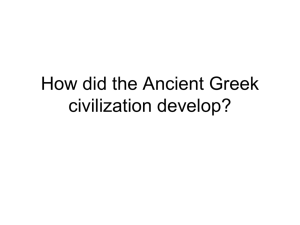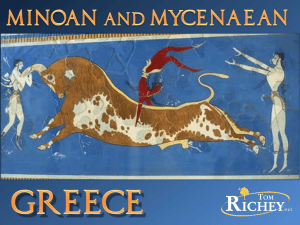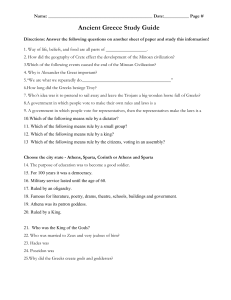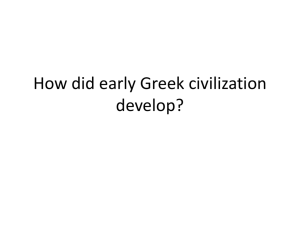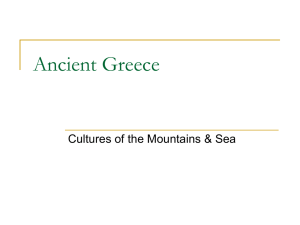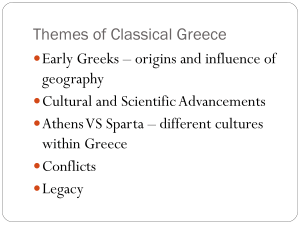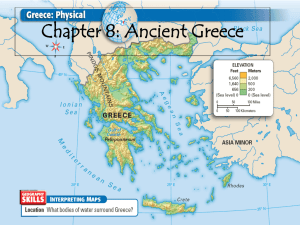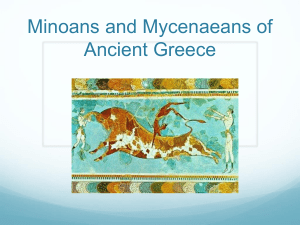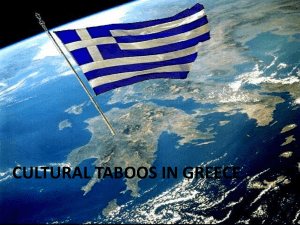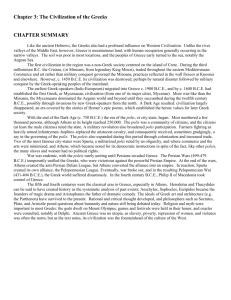WHICh5Sec1-2Minoan-Mycenaean-DarkAge-worksheet-2014
advertisement
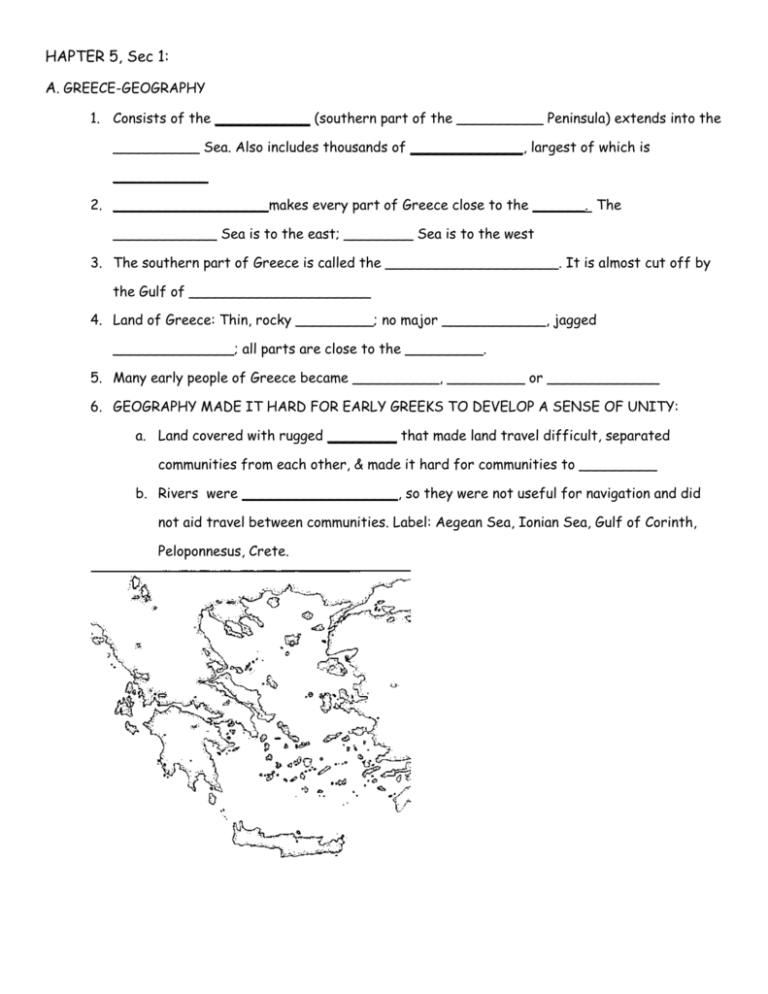
HAPTER 5, Sec 1: A. GREECE-GEOGRAPHY 1. Consists of the ___________ (southern part of the __________ Peninsula) extends into the __________ Sea. Also includes thousands of _____________, largest of which is ___________ 2. __________________makes every part of Greece close to the ______. The ____________ Sea is to the east; ________ Sea is to the west 3. The southern part of Greece is called the ____________________. It is almost cut off by the Gulf of _____________________ 4. Land of Greece: Thin, rocky _________; no major ____________, jagged ______________; all parts are close to the _________. 5. Many early people of Greece became __________, _________ or _____________ 6. GEOGRAPHY MADE IT HARD FOR EARLY GREEKS TO DEVELOP A SENSE OF UNITY: a. Land covered with rugged ________ that made land travel difficult, separated communities from each other, & made it hard for communities to _________ b. Rivers were __________________, so they were not useful for navigation and did not aid travel between communities. Label: Aegean Sea, Ionian Sea, Gulf of Corinth, Peloponnesus, Crete. B. DISCOVERY OF MINOAN CIVILIATION – ANCIENT CRETE 1. Earliest Civilization in Greece was on Crete-“____________” (About 3000BC-1400BC) 2. Named _________ for ______, legendary king of Crete in the story of ________ 3. Discovered in the late 1800s by Sir Arthur __________ C. LEGEND OF THESEUS-legend with bits of truth 1. Crete was powerful country ruled by king _________ 2. Half-man half-bull called the _________ that was kept in huge, mazelike building called the _________ on Crete 3. Bits of truth: There was a great civilization on the island of ____________; The Labyrinth may correspond to the Palace of ____________; the Minotaur story may have a connection with the worship of _________ or the bull-leaping sport on Crete. MINOAN CIVILIZATION ON CRETE 1. Arose by ____________BC 2. Centered around several palace centers, the largest being the Palace of ________. 3. Palace of K_____________ (over 1500 rooms) a. the residence of the r________ and the hub of the society b. many rooms for the storage of ___________ to be traded and where ___________ worked ; also rooms with religious shrines. c. Beautiful open s________ & beautiful f______ (paintings made on wet plaster) d. Advanced plumbing, including r_______ water & s_______ drains 4. Writing, called “_______ _ ”, but it has not been deciphered-language unknown 5. People were s_______ & t_________. Crete set up trading posts on other Aegean islands & was a hub of Mediterranean t________ 6. Relatively ________ – no fortification walls, but had a strong navy to protect trade. 7. Religion: b_______ and a m________ goddess played an important role 8. Art a. Shows a joyful culture, appreciation of n_______, much time spent outside. b. Famous frescoes include: b_____ jumping, elegant l____; leaping d_____ 9. _________ apparently had high status, because they are represented in art more often than men and appear to be moving freely in society. 10. About 1628BC-powerful v________ eruption on the nearby island of ________ caused damage on Crete. Minoan civilization d_______ but did not c________ 11. About 1450BCa. Crete was invaded & conquered by m_______ Greeks called M________ Greeks. b. We know this because in 1450BC, they abruptly changed w________ systems; stopped using L_____ __ started using L______ __. c. Linear __ – remains an un-deciphered writing system, unknown language Linear __– writing system deciphered in 1953 by Michael Ventris; the language is an early form of Greek 12. About 1400BC a. Palace of K_________ was abandoned; the civilization ___________ b. Cause? Ch5, Sec 1, continued – Mycenaean Civilization 1. Who were the Mycenaeans? Where did they live, and during what period did they control Greece? 2. What was the name of their largest city, and who excavated it? 3. Were the Mycenaeans more peaceful or more warlike, than the Minoans? How do we know? 4. Were they wealthy or poor? How do we know? 5. Describe the society of the Mycenaeans. How were people grouped? Who was the highest ruler? 6. Who was the leader of all the Mycenaean Greeks? 7. Did the Mycenaeans have a written language? What was it? Has it been deciphered? What was their spoken language? 8. What did the Mycenaeans do around 1450BC? 9. What did the Mycenaeans do around 1250BC? 10. Was there really a Trojan War? What 2 great epics were later written about the Trojan War? Who (according to tradition) wrote them? What are they about? 11. What do they tell about the Greeks and their values? 12. What was happened around 1200BC? What was the situation in Greece by 1100BC? 13. What are some of the possible reasons for the destruction of Mycenaean Civilization? Ch5, Sec 1, cont. Dark age & revival, Political organization 14. What was happening by 1200BC? What happened by 1100BC. 15. What/when was the “dark age” of Ancient Greece? What declined during this period? What skill was lost? 16. What happened around 800BC? What happened in regard to literature about 750BC? 17. What else happened 750BC, in regard to movement of people? Why did this happen? What was the cultural result of this? 18. What was a polis? 19. Describe the features and lay-out of a polis. 20. How did Greeks tend to feel about their own polis and about others? 21. Despite the sharp divisions between poleis, what did all Greeks have in common? Ch5, Sec 2 A. Explain these aspects of Greek religious beliefs. 1) Greek religion did not: 2) Greeks looked to religion for: 3) Beliefs about the afterlife 4) Myths, characteristics of the gods/goddess 5) Olympian gods/goddess 6) Oracles 7) Sacrifices 8) Games B. Explain how the government of a polis evolved and changed: 1) Monarchy (Before about 800BC) 2) Aristocracy (Between about 800BC-700BC) 3) Oligarchy (Between about 700BC-600BC) 4) Tyranny (Between about 600BC-500BC) 5) Democracy (After about 500BC) C. 1) About when did Greeks begin to use iron weapons? 2)What was a phalanx? What was a hoplite? 3) How did change in the military contribute to the evolution & change in government? READ: When Greeks settled in these small districts, they were organized by institutions based on kinship, real or imagined. Small as each area was, it was sufficient for the limited number of settlers and their pastoral and agricultural ways of life. Generation after generation of people lived in the same way, tending their flocks, cultivating their fields and occasionally being called together to repel some raid from beyond the borders. In these self-sufficient societies, a deep love arose for the soil on which life itself was dependent. In these restricted districts, some of which were only a few miles in length and width, the inhabitants became familiar with every natural feature, with every hill and ravine, tree and stream. Shrines and altars to heroes, nymphs and various vaguely conceived spirits gradually arose, making the land--which was already sacred from the tombs of the ancestors--even more holy. And on the acropolis lived the protecting deity or deities of the community. People living amid these intimate and familiar scenes, generation after generation, must have acquired a sense of belonging which is almost impossible for residents of today's urban monstrosities to understand. Each community developed its own traditions and special ways of life which were intimately linked with the land, and the conviction grew that its ways were better than those of other communities. Thus, by the time that increasing population rendered it no longer possible for growing states to be self-sufficient and made it desirable for communities to combine their resources by uniting in larger groups, the inhabitants of each state were so passionately attached to their city and its lands and traditions that the idea of merging with another state and thus forfeiting part of their identity was unthinkable. John V.A. Fine, The Ancient Greeks, Cambridge: Harvard University Press, 1983.
